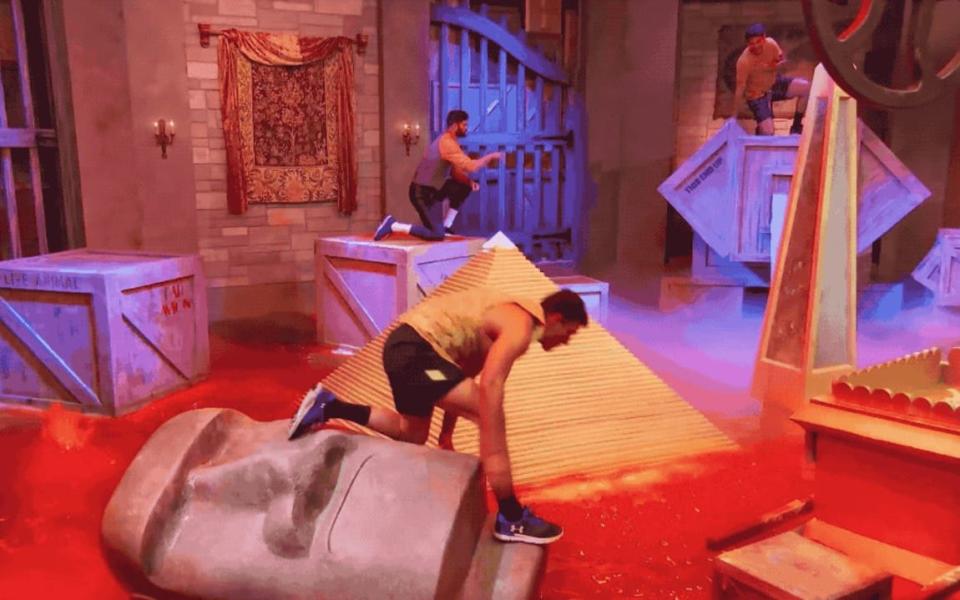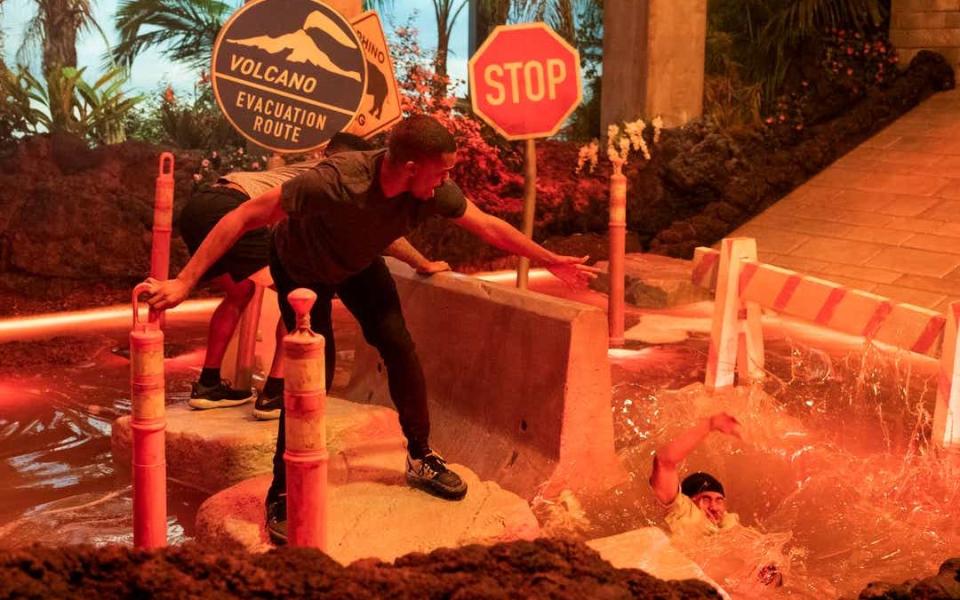Floor Is Lava: how Netflix's health and safety nightmare became a reality

When Megan McGrath, executive producer of Netflix’s Floor is Lava, first conceived of the idea for the gameshow that’s rocketed up the charts, she was reminiscing about playing with her brother, trying to get across the living room without touching the floor. “I was reminded of playing Floor is Lava with my brother and immediately thought this could be a fun idea for a gameshow,” she says. “We just needed to supersize it.”
She took the idea to her colleague, Irad Eyal, and the two developed the idea into a proposal that Netflix greenlit for a series. The next problem was finding where to film it. The executive producers knew they’d need a vast soundstage and studio space in which to construct their set, which comprises a giant tank filled with goop and amazingly lifelike renditions of a giant mansion – contestants clamber over kitchen tables and swing from curtains in an effort to avoid the luminous red lava and claim the $10,000 prize. It’s perfect pandemic watching: a childlike dream faithfully recreated, with elements of Total Wipeout meets The Borrowers.
Los Angeles isn’t short of soundstages, and new gameshows happen all the time (or at least, they used to). But something gave studio owners pause. “Every studio we contacted said you can’t bring 100,000 gallons of lava into our space – that’s not going to work for us,” says Eyal. Even a famous Hollywood studio containing a giant tank that’s been used in many movies with water scenes blanched at the idea. So the producers improvised, finding an old IKEA seven miles north of Hollywood in Burbank, California, that became the home of the series.
“It turned out to be the perfect space,” says Eyal. “It was a massive, massive room. It’s very structurally sound, and then there were also spaces back where they’d have the kitchen viewing area or the children’s area, that’s where we’d have our welding shop, our carpentry shop. We took over the entire space and it worked perfectly.”
The show’s hundreds-strong team of welders, woodworkers and painters – as well as the casting team, camera crew and challenge department, who devised increasingly tricky tasks for contestants to complete, all while avoiding the lava – moved into the abandoned shop, while the parking lot was filled not with shoppers looking for Billy bookcases but industrial-scale slime tanks.
Those tanks contained the lava, which was developed in a three-month process that involved 50 different iterations of slime, concocted by the top chemist in Los Angeles that provides material to movies. (The company were behind the slime dripping from the alien’s mouth in 1986’s Aliens, and the goop in Ghostbusters.)
“We tasked them with coming up with a new formula for us that had the right viscosity, the right slipperiness, the right glow to it. So once we nailed that down, we said, ‘Great, we need 100,000 gallons,’ which was more than anyone had ever ordered.”

The 100,000 gallons of goop took several hours to fill the tank that the welders and carpenters built in the set, piped in through hoses that lay where shelves storing IKEA pots and pans used to sit. “Lava is heavier and slower than water, so it doesn’t pour in like a faucet,” explains McGrath. “It globs in like lava. So it took a little longer than you would expect.”
The moment that happened, the day before filming started on the show, was a stirring moment for Eyal. “You hear it echoing over the walkie-talkies: ‘Turn on the pumps’. And all of a sudden this flood of lava comes in and the space comes to life, and you can really see how it all fits together, once that lava rises.”
Contraptions built into the tanks that can bubble, wave and send lava shooting up in a volcanic eruption, were tested in a North Hollywood garage and are controlled by automated systems – though the directors can call on it on an ad hoc basis, too. When a contestant falls into the morass, they disappear as their teammates cry out for their loss.
The over-the-top reactions, plus the interactions between contestants as they try and navigate the trickier elements of the obstacle course, are part of what makes the show such a success. The Virzi triplets, brash, hypercompetitive comedians, are some of the show’s early viral stars, simply because of the vast gulf between their confidence and their ability. One of them takes an especially brutal jaw-first fall just before the finish line, and it's a joy to behold.
The contestants take thrills and spills, but don’t get hurt. When asked whether the show – clamber, jump and run through a room filled with cluttered furniture, often with sharp and seemingly hard edges – was a health and safety nightmare, Eyal jokes: “There are no lawsuits in the US – it’s fine! We can do whatever we want,” before adding that almost every prop used was built from scratch or re-engineered to look realistic but prevent people from getting injured.
“We wanted it to feel real and immersive. We didn’t want them to wear helmets or knee pads or wrist guards, or anything like that which you see on other shows,” he says. “The designers, the stunt co-ordinators and the challenge department really had to think very carefully about how do you make these sort of epic sets that allow for big leaps, swings and jumps, and yet if you fall on your face or hit your chin, you’re not going to be permanently damaged in any way.”
It’s a silly show, but it’s perfect for these strange times. “In this weird way, everyone is stuck inside, everything’s scary and there’s no sports,” says McGrath, who thinks the lack of competitive sports has helped propel the show to the top of the Netflix rankings. “You’re either rooting for the contestants or you’re rooting for the lava, and sometimes that depends on the episode or the theme. You can flip back and forth. It cut through the clutter, and people are looking for something that will make them laugh and bring their family together and that’s what it’s doing.”

Eyal, the father of three children, has another explanation. “I can tell you, being locked in quarantine and having something that can occupy the kids for five hours that is also fun for adults is worth its weight in gold,” he says.
Plenty of people seem to agree. As well as huge numbers of ordinary people tweeting about it, celebrities including Lin-Manuel Miranda have seemingly got hooked, too. “There have been a lot of celebrities on Twitter who have tweeted at us or the show, saying if there’s a season two, sign me up. We would love to do a celebrity version, a kid’s version, we want to do it all,” says McGrath.
Whether that happens is up to Netflix. “Obviously the show has resonated with people across the show, and we’ve been on top of the charts on Netflix was amazing and fantastic and surprising. But Netflix has their own secret, proprietary metrics. Until you tick all those boxes, we won’t know if we get a second season, but we’re hoping so,” says Eyal. Both executive producers and their team have already come up with ideas for a second series – and built in hints for future rooms into the show, which the camera sweeps by in a flash as contestants move through the mansion.
“Everybody who played it wants to come back and play it again,” explains McGrath. “And I would love to let more people live out that childhood dream of swinging from the curtains and jumping on the kitchen table. It’s just fun.”

